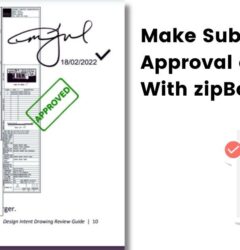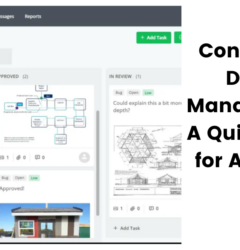A Comprehensive Guide to Improve Your Construction Submittal Process (with Free Template)
04 Jul

Table of Contents
ToggleWhen you’re involved in any construction project, you need to know about the construction submittal process. What a submittal is, its purpose in the construction industry, and how to efficiently improve the entire process. So whether you’re just starting or brushing up on your knowledge, we’ve got you covered.
What are Construction Submittals and Why are They Important for Your Project?
Construction submittals are essential documentation, allowing the project stakeholders to confirm that the right components are approved for installation where they are supposed to go.
Either the contractor or subcontractor prepares the submittals. Construction submittals can include multiple elements, and they often contain data, samples, shop drawings, production specifications, and other written and physical information that will help engineers, designers, and architects to ensure that appropriate materials are used for new constructions.
It is critical to manage construction submittals properly because it determines how well your proposed timeline will run, the details of your budget, and the accuracy of the final product. This is where the review process comes in.
Watch the video👆
What Does a Construction Submittal Process Entail?
A construction submittal process involves the sequence of steps and activities involved in submitting and reviewing construction-related documents, materials, and plans from contractors or suppliers to the project owner, architect, or general contractor for approval. This process ensures that the submitted materials comply with project specifications, codes, and regulations before they are used in the construction project. Here’s how a standard submittal process looks like:
- Document Preparation: Contractors or suppliers prepare documents, drawings, specifications, product data, samples, and other relevant information as required by the project’s specifications.
- Compilation of Submittal Package: Contractors gather all the prepared documents and materials into a comprehensive submittal package. This package typically includes cover letters, submittal registers, submittal schedules, transmittal forms, and any other required administrative paperwork.
- Submittal Submission: The contractor submits the submittal package to the responsible stakeholder, which could be the architect, engineer, general contractor, or owner, depending on the project’s organization and contractual relationships. The contractor or subcontractor can submit the submittals physically or electronically, using specialized software.
- Initial Review: The architect or engineer reviews the submittals to ensure that they comply with project requirements, codes, and regulations. The review ensures that the proposed materials and methods align with the project’s design intent.
Reviewing construction submittals in zipBoard
- Comment and Correction Cycle: If the initial review identifies any discrepancies, errors, or omissions, the responsible party will provide feedback to the contractor. This might involve requests for revisions, clarifications, additional information, or corrections to the submittal documents.
- Resubmittal: Based on the feedback from the reviewers, the contractor revises and updates the submittal package to address the comments and corrections. This resubmittal might involve modifying drawings, updating specifications, or providing more detailed information.
- Secondary Review: The reviewers review the revised submittal package again to ensure that all the contractor or subcontractor effected all the changes they requested and that the updated documents now comply with the project’s requirements.
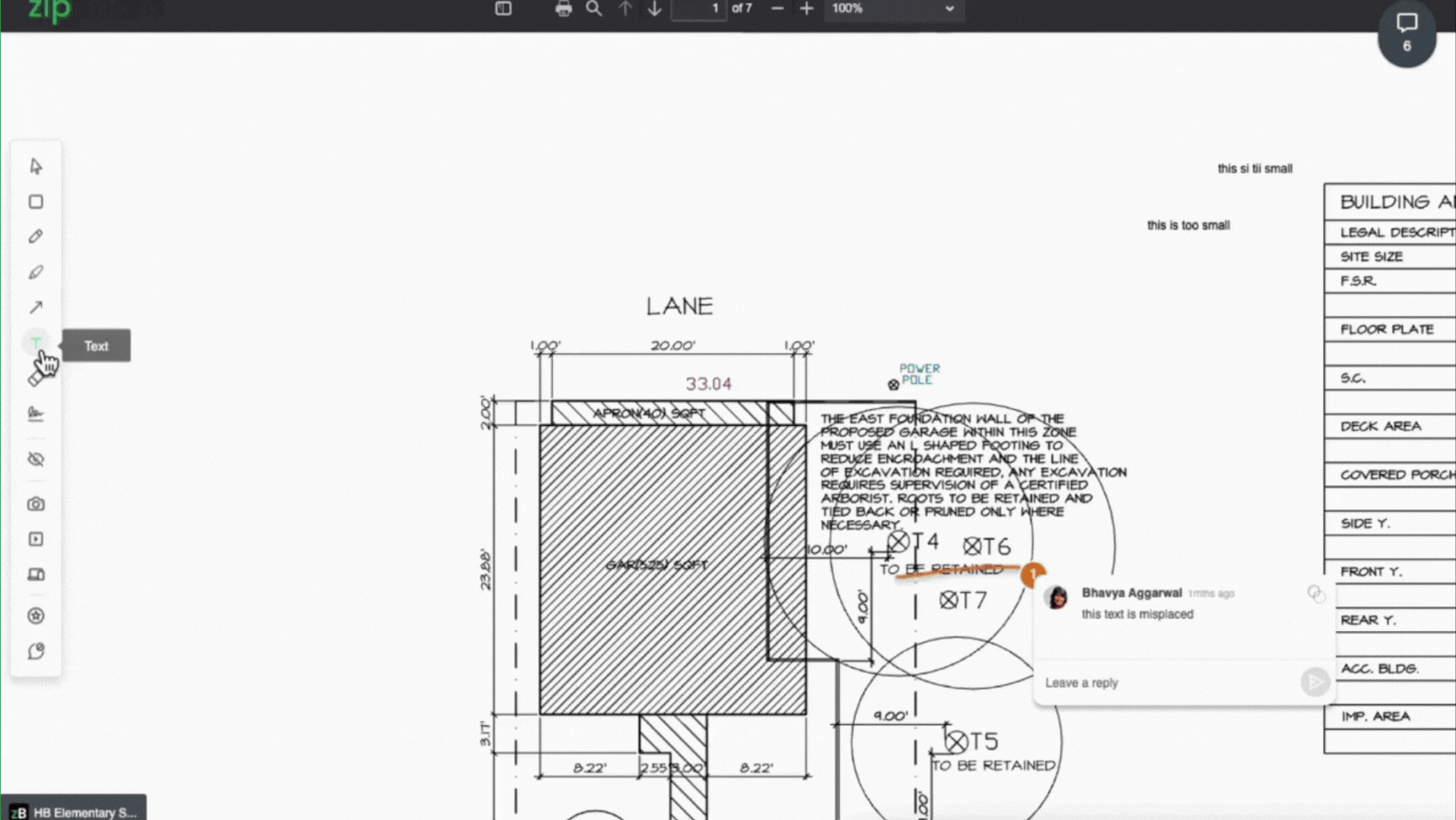
- Approval or Rejection: Once the architect or engineer finds the submittal package compliant and satisfactory, they approve it. If the submittal package does not meet the project’s specifications even after multiple revision cycles, they will reject it, and the process returns to the correction cycle.
- Distribution and Implementation: Approved submittals are distributed to relevant parties, such as contractors, subcontractors, and suppliers. These approved documents serve as the basis for procuring and installing materials and executing work on the construction site. To streamline this process, you can use supply chain execution software to ensure that all stakeholders receive the correct information in real-time, reducing delays and improving project efficiency.
- Record Keeping: All approved submittals, correspondence, and documentation related to the submittal process are typically maintained as part of the project’s record-keeping system.
It’s worth noting that throughout the process, effective communication, collaboration, and documentation play crucial roles in ensuring that the construction project progresses smoothly, materials are of the required quality, and compliance with project specifications is maintained. The exact steps and participants can vary based on the project’s complexity, contractual relationships, and the specific roles of the parties involved.
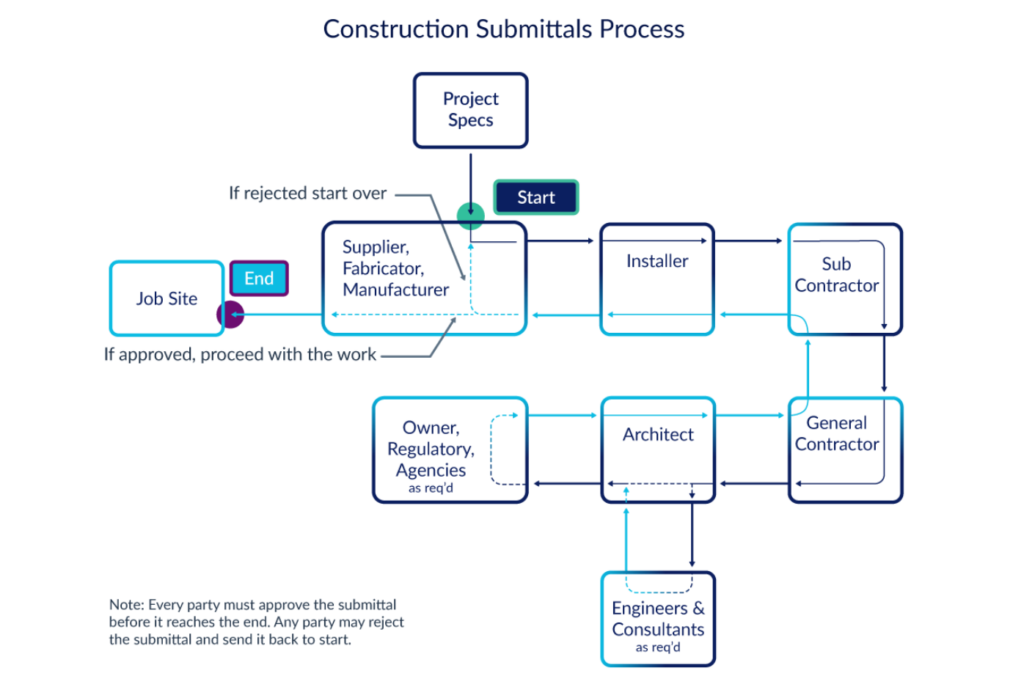
Types of Construction Submittals and the Information They Include
It’s not always easy to classify submittals into set types. But to simplify the ordeal, we generally accept that there are four types of submittals.
Product Data & Materials Data
The product & materials data include information about the products purchased to be used for the work. They can be further classified into three types.
- Prescriptive Specifications: Details how-to instructions on usage and installation of the product.
- Performance Specifications: Describes the qualities of the material, regardless of the manufacturer.
- Proprietary Specifications: Describes the make and model of the product by a specific manufacturer.
Shop Drawings
Shop drawings are highly detailed drawings prepared to show verified, exact field dimensions, joinery, materials, thicknesses, etc.
Here, the architects and engineers need to make sure that the configurations are in alignment with the contract documents. These submittal documents are the bedrock for most construction projects.
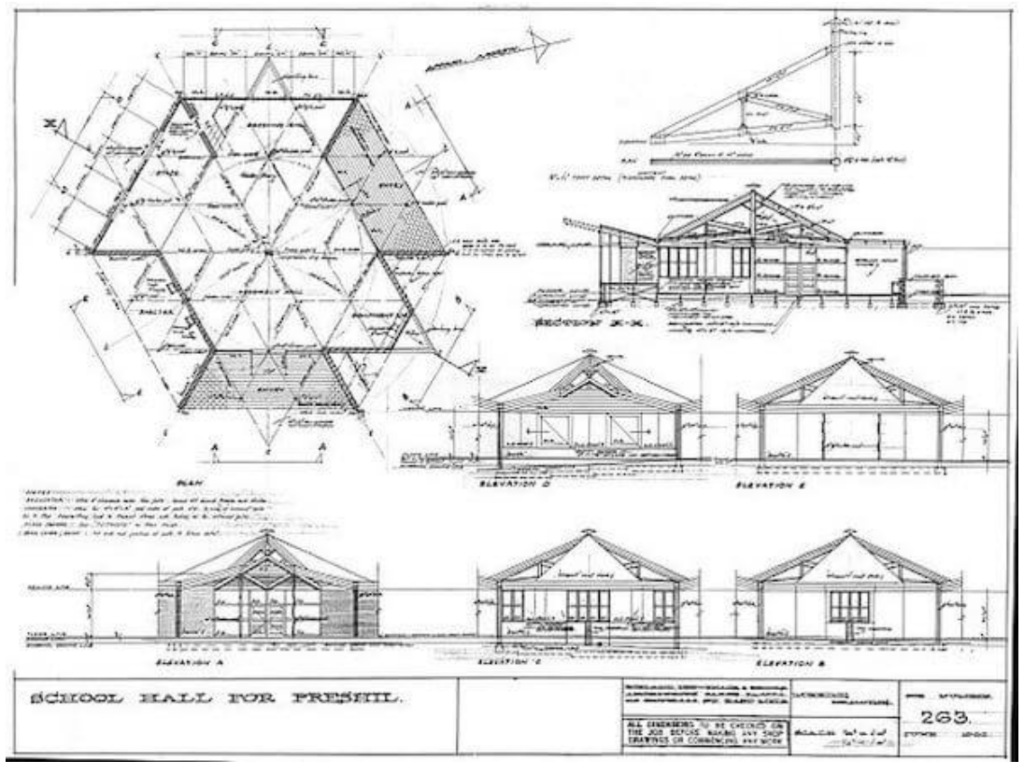
Samples
In most cases, samples are needed for surfaces – masonry, carpet, countertops, fixtures – so they can be examined for their finish, density, and color.
Marble, for instance, varies from one quarry to another. All of these details are taken into care in this submittal document.
Mock-Ups
Mock-ups show how a larger assembly will be built by building a small portion of it on-site. Compared to other types of submittals, mock-ups are far less common, yet they have saved many a project from failure. These work as a prototype for the upcoming construction.
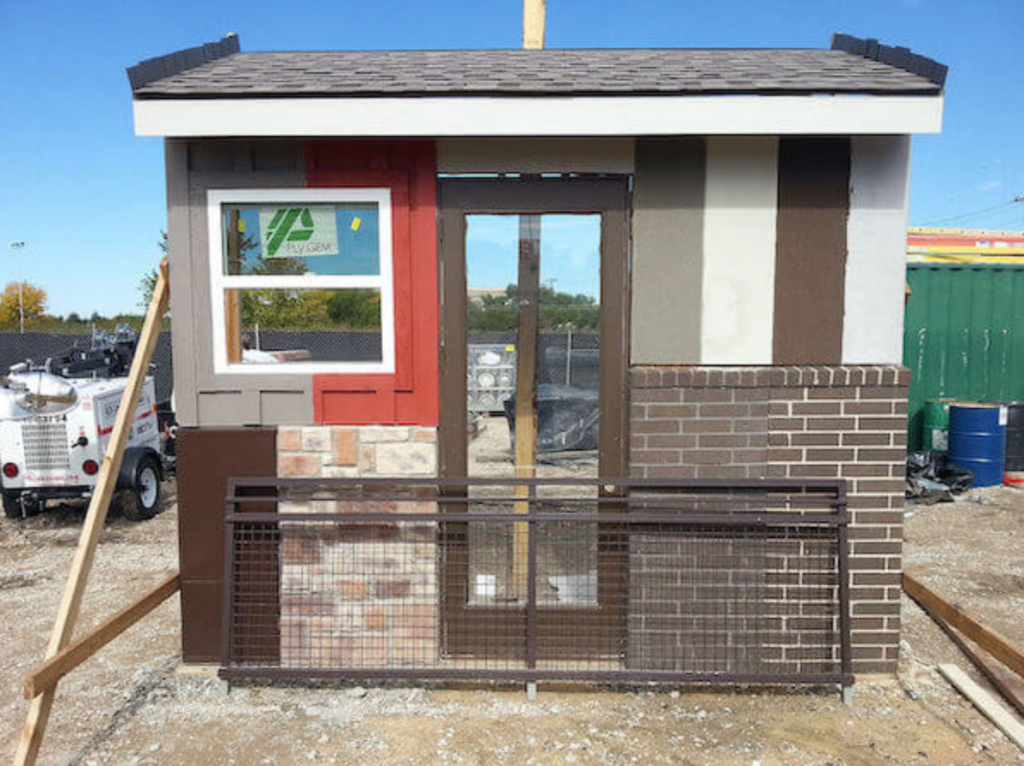
The Construction Submittal Review Process
The submittal review process is a specific phase within the broader submittal process. It involves evaluating the submittals for compliance with project specifications, codes, regulations, and design intent before they are implemented in a construction project.
Once the contractor submits the construction submittals, the engineers and architects must approve the materials for compliance with the owner’s contract. They must also sign off for appearance, safety, and quality. This gives the go-ahead for the project.
In large projects, the submittal review process is usually formalized and clearly outlined. However, it’s always a best practice to establish the review process beforehand to avoid any friction later on. You can save enormous potential trouble, but the process can be tedious without a construction submittal review tool.
Steps Involved in the Construction Submittal Review Process
- Receipt of Submittal: The process begins when the contractor or supplier submits a package of documents, drawings, specifications, samples, and other relevant materials to the responsible party (architect, engineer, general contractor, owner, etc.) for review.
- Comparative Analysis/ Document Verification: The architect or engineer compares the submittals against the project’s requirements and the information provided in the contract documents. This may include drawings, specifications, product data, samples, and any other relevant information. The reviewer identifies and documents any deviations, discrepancies, or inconsistencies.
- Initial Review: The architect, engineer, and other responsible parties examine the submittals to ensure that they meet the project’s design intent, specifications, codes, regulations, and quality standards. This review might encompass factors such as materials’ suitability, functionality, compatibility, and compliance.

- Technical Review: The architect and engineer, together with other relevant stakeholders like consultants or construction manager (depending on the project) access the technical aspects of the submittal. This will usually involve verifying that the proposed materials are compatible with existing systems, assessing structural integrity, evaluating performance data, and confirming adherence to safety regulations.
- Design Intent Evaluation: The architects, engineers, and construction manager evaluate the submittals to ensure they align with the original design intent and aesthetic goals of the project. This ensures that the final construction matches the envisioned outcome.
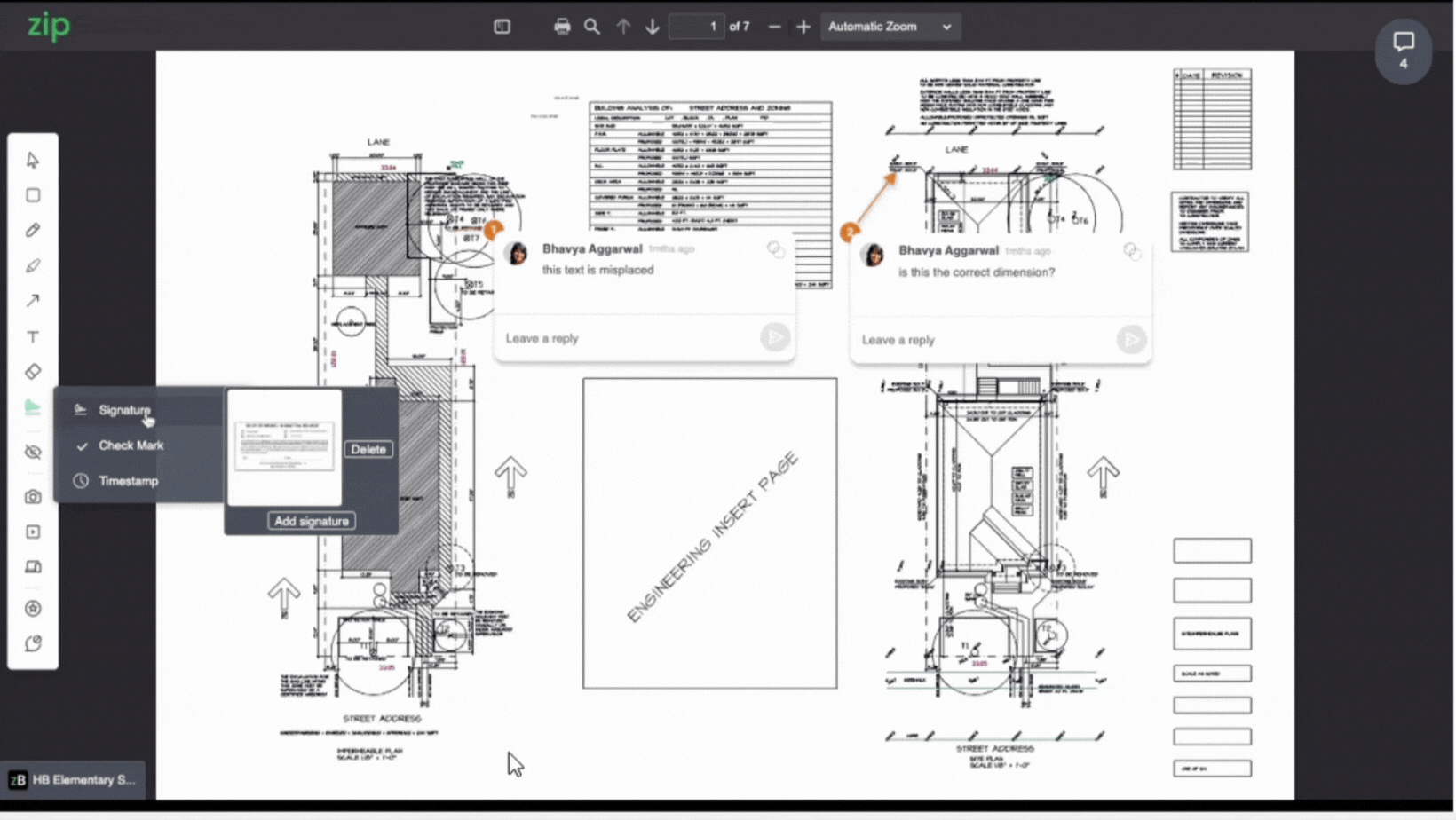
- Coordination with Other Trades: The General Contractor, Subcontractors, and the Construction Manager review the submittals to ensure that the proposed materials and systems are compatible and will function as intended within the larger project context.
- Value Engineering: Sometimes, architects and designers, engineers, contractors, and project owners collaborate to suggest alternative materials or methods that provide cost savings or improved performance while still meeting project requirements.
- Documentation and Comments: All stakeholders in the submittal review process document and share their issues, concerns, or comments they identified during the review. Subsequently, the project manager communicates these comments back to the contractor or supplier, specifying the required changes or clarifications.
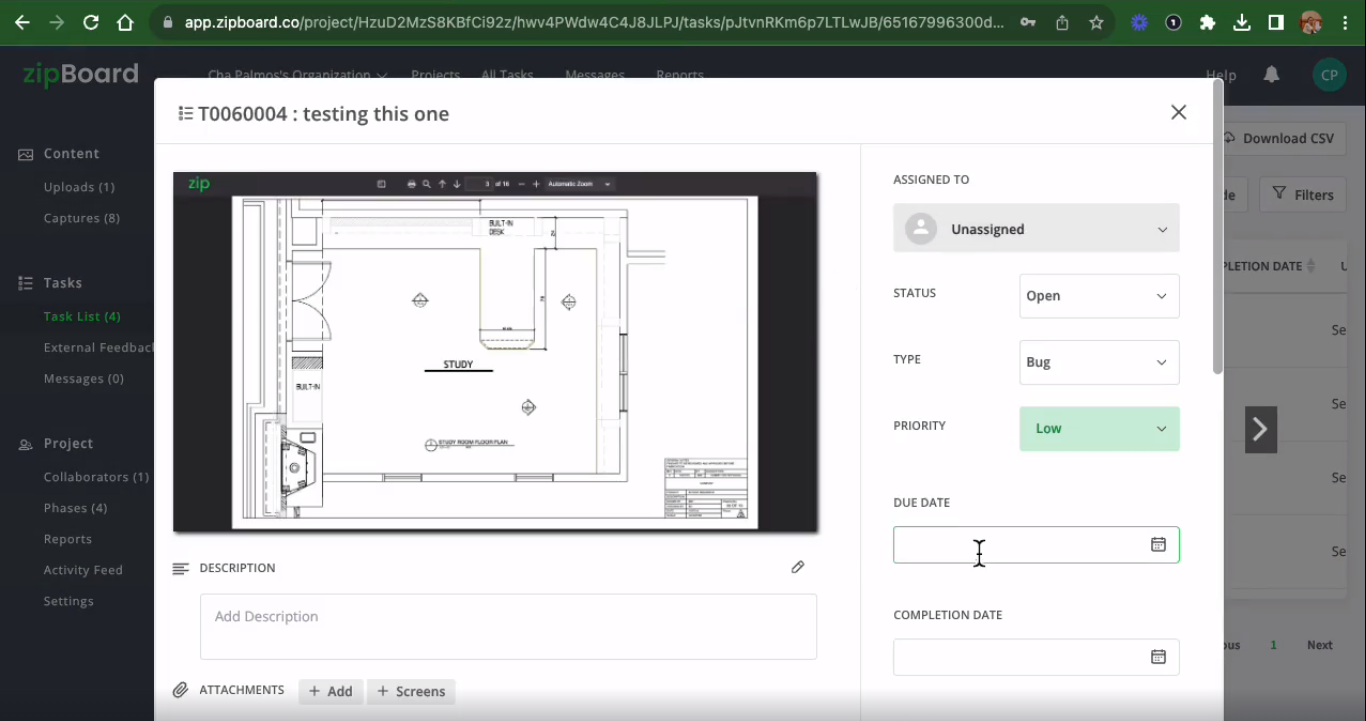
- Request for Revisions: The contractor or supplier revises the submittal package based on the comments provided. Once they have a hold of what is required, they make changes to drawings, specifications, data sheets, or any other relevant documents.
- Resubmittal: The contractor resubmits the revised submittal package to the architect and engineer for reevaluation. The review process continues iteratively until the submitted materials are found to be compliant and in alignment with project requirements.
- Final Approval: Once the submitted materials satisfactorily address all comments and concerns, the responsible party – usually the architect or engineer – grants final approval. This approval signifies that the materials are authorized for use in the construction project.
- Record Keeping: The project manager ensures that the documentation, correspondence, and records related to the submittal review process are maintained for future reference, for audit purposes, and as part of the project’s documentation.
Note: The construction submittal process requires effective collaboration, attention to detail, and a thorough understanding of the project’s specifications and requirements to ensure consistency, project quality, and compliance to regulatory standards.
How to Set Up a Submittal Review Process
Setting up an effective submittal review process involves establishing clear procedures, communication channels, and tracking mechanisms to ensure that submitted materials are thoroughly reviewed, approved, and integrated into the construction project. Here’s a step-by-step guide to help you set up and manage a successful submittal review process:
- Define the Submittal Review Workflow: Clearly outline the sequence of steps involved in the submittal review process. This includes document preparation, submission, review, comments, revisions, resubmission, and final approval. Ensure all stakeholders understand the workflow.
- Identify Key Stakeholders: Determine who will be involved in the review process. This could include architects, engineers, designers, general contractors, subcontractors, suppliers, and regulatory authorities. Clarify roles, responsibilities, and decision-making authority.
- Develop a Submittal Register: Create a centralized database or document where all submittals are tracked. Include information such as the submittal’s reference number, description, status, due date, reviewer’s name, and comments.
- Select Submittal Review Software: Consider using construction project management software designed for submittal tracking. These tools can help improve the review process, automate workflows, manage deadlines, and improve communication among stakeholders. A submittal review and approval like zipBoard provides mark-up tools for document reviews, as well as issue tracking tools for easy submittal tracking and project management. The good part is that it can easily integrate with your DMS.
- Establish Communication Protocols: Define how communications related to submittals will be conducted. Specify the preferred communication channels (email, meetings, or collaboration platforms like Slack and MS Teams) and frequency of updates.
- Create Review Templates and Guidelines: Develop standardized review templates that outline the criteria for evaluating different types of submittals (drawings, specifications, samples, etc.). The guidelines should cover technical requirements, compliance with codes, design intent, and quality standards.
- Set Review Turnaround Times: Establish realistic timeframes for completing each review cycle. This ensures that submittals are processed efficiently while allowing enough time for thorough assessment.
- Coordinate with Trade Partners: Collaborate with subcontractors, suppliers, and other trade partners to communicate the submittal requirements, review expectations, and deadlines.
- Initiate the Review Process: When you receive a submittal, assign it to the appropriate reviewer based on their expertise. Notify the reviewer of the submittal, including its content, due date, and review guidelines.
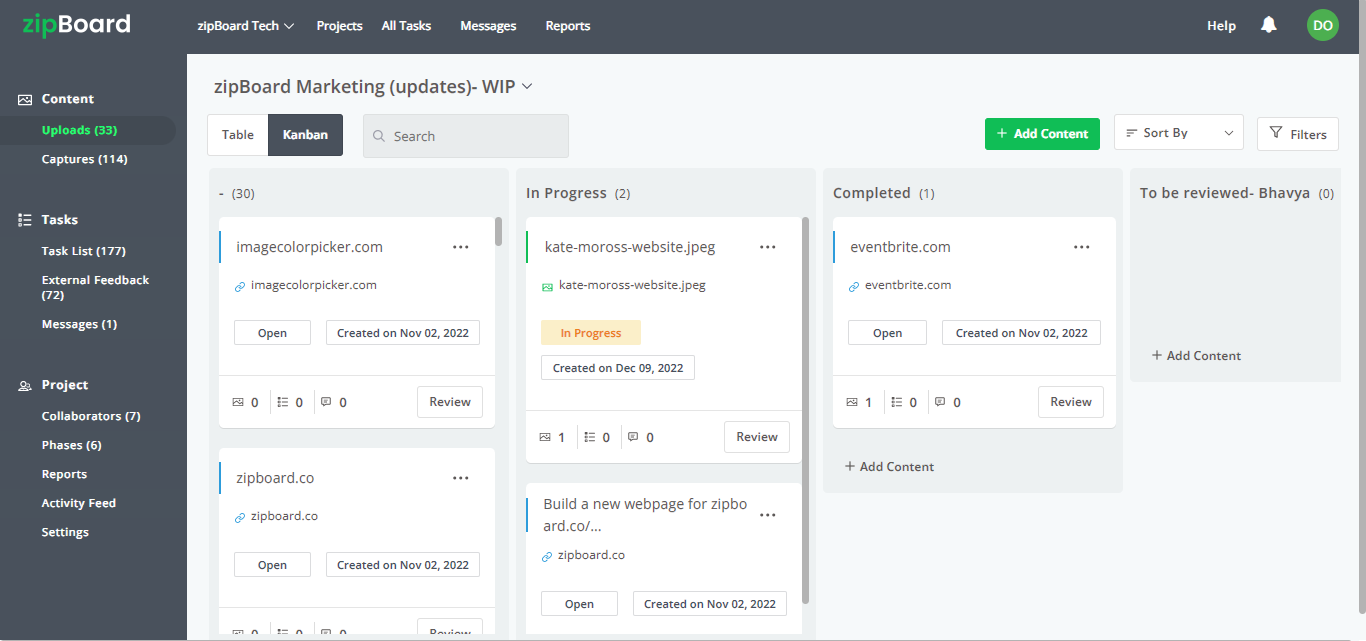
- Review and Provide Feedback: Reviewers assess the submitted materials according to the established criteria. They provide detailed comments and suggestions for improvements or revisions.
Note: A manual review process is prone to construction documentation errors and will delay the submittal review process. However, using visual review and approval tools for AEC documents like submittals will ensure clarity of feedback, prevent comments in long email threads or in spreadsheets, and save about 50%+ time on reviews to move the project to production faster.
- Track Review Progress: Regularly update the submittal register to reflect the status of each submittal (e.g., “Under Review,” “Pending Revisions,” “Approved,” “Rejected”). This allows for quick visibility into the overall progress.
Note: A construction submittal management tool like zipBoard can help remove the friction in using spreadsheets to track and review progress.
- Communication of Comments: Communicate review comments and feedback to the contractor or supplier in a clear and structured manner. Use the established communication channels to ensure everyone is on the same page.
- Review Revisions: Review resubmitted materials to verify that the requested changes have been implemented accurately and completely.
- Final Approval: Once the submittal meets all requirements and passes review, ensure that the appropriate stakeholders sign off on the materials to be used in the construction project.
- Document and Archive: Maintain a record of all submittals, review comments, revisions, and approvals for future reference and audit purposes.
- Continuous Improvement: Regularly assess the efficiency and effectiveness of the submittal review process. Seek feedback from stakeholders and identify areas for improvement to streamline the workflow.
What Should I Look for When Reviewing Submittals?
Generally, every stakeholder in the construction submittal review process needs to look out for items like the submittal transmittal, contractor’s approval stamp, timelines, project information, and number of copies of submittals before reviewing any submittal:
However, project/construction managers, architects, engineers, contractors, clients, and all other stakeholders would need to review different aspects of the submittals. So what do you have to look for based on your role in the project? Find out here:
Project Manager
As the central coordinator, focus on the overall alignment of submittals with the project’s timeline, budget, and scope. Keep an eye on:
- Schedule Adherence: Ensure that stakeholders conduct submittal reviews within the established timelines to prevent delays in the project.
- Budgetary Implications: Verify that the proposed materials and methods align with the project’s budget, preventing unexpected cost overruns.
- Scope Consistency: Confirm that submittals are consistent with the project’s scope and design intent to maintain the desired outcome.
Architect or Engineer
Architects and engineers ensure that submittals align with the project’s design intent, technical requirements, and regulations. As an architect or engineer, look out for:
- Design Intent: Evaluate whether the submitted materials align with the design concept and architectural vision.
- Technical Compliance: Ensure that proposed materials, systems, and methods adhere to technical specifications and standards.
- Code Adherence: Verify that submittals comply with local building codes and regulations.
General Contractor
General contractors focus on the feasibility of implementing the submitted materials within the construction process. As a general contractor, consider:
- Constructability: Assess if the proposed materials can be installed efficiently and without conflicts on the construction site.
- Coordination: Ensure that the submittals fit seamlessly into the overall construction plan and do not clash with other trades or activities.
- Trade Partner Coordination: Verify that submittals from various subcontractors align with each other and with the general construction schedule.
Subcontractors and Suppliers
Subcontractors and suppliers ensure the feasibility and quality of the materials they will provide. As a subcontractor or supplier, pay attention to:
- Material Suitability: Verify that the proposed materials match project specifications and are suitable for the intended use.
- Quality Standards: Ensure that the provided materials meet the required quality standards and performance expectations.
- Logistics: Assess the availability and delivery timeline of the materials, taking into account lead times and on-site requirements.
Owner or Client
Owners or clients ensure that the submittals align with their vision and expectations for the final project outcome. Are you the owner or client? Focus on:
- Aesthetic and Functional Goals: Verify that the submittals match the desired aesthetic and functional outcomes as communicated to the design and construction teams.
- Long-Term Goals: Consider how the proposed materials align with long-term maintenance and operational goals for the facility.
- Value Engineering: Assess whether the submittals provide value for the investment and meet the owner’s requirements.
Overall, it’s important to assess submittals from your unique perspective to ensure a comprehensive review that considers design, technical compliance, feasibility, budget, and the overall project vision.
9 Proven Strategies to Streamline and Improve Your Construction Submittal Process
Most contractors, project managers, engineers, and architects struggle with reviewing submittal documents. Let’s look at how to ease this process with the 9 proven strategies we’ve compiled while working with major construction clients. These best practices for submittal reviews will help enhance your process.
1. Streamline the Review and Approval Cycle
When there are strict deadlines to meet, people often panic, and rush through things, trying to pass through submittals quickly, to stay on schedule. This becomes an even bigger challenge for distributed teams working with documents all over the place. This is why a streamlined submittal review and approval cycle is paramount to meeting the deadlines.
Just think about this, when was the last time you revamped your construction review & approval process?
As every team has its process, there’s no one-size-fits-all.
But a general trend we’ve noticed with the highest-performing construction companies is:
- Centralize
- Secure
- Digital review & sign off your submittals
Let’s take an in-depth look at it, which is also our next strategy to improve the construction submittal process.
Click to watch video👆
2. Track Tasks, Responses, and Due Dates in a Centralized Place
Earlier we touched on the steps high-performing construction companies take to streamline their review cycle. Now let’s see why the three steps work.
- Centralize all your submittals: This way you’re not only making it easier for the stakeholders to review the documents but also sparing yourself from managing the thousands of documents that are about to pile up, version after version.
- Host the files on your trusted ERP/server: This is very important from a security and privacy point of view. Any additional tools you use should be accommodating and respecting of this point. If you do not have a system set up, worry not as some tools even allow you to host your file on a server of your location choice.
- Use a submittal markup tool: Now that you’ve got your documents centralized and secured on your server, how do you start reviewing them? The best approach is to use a construction submittal review tool that integrates with your system, and lets you annotate right on top of your document without the file ever having to move between tools.
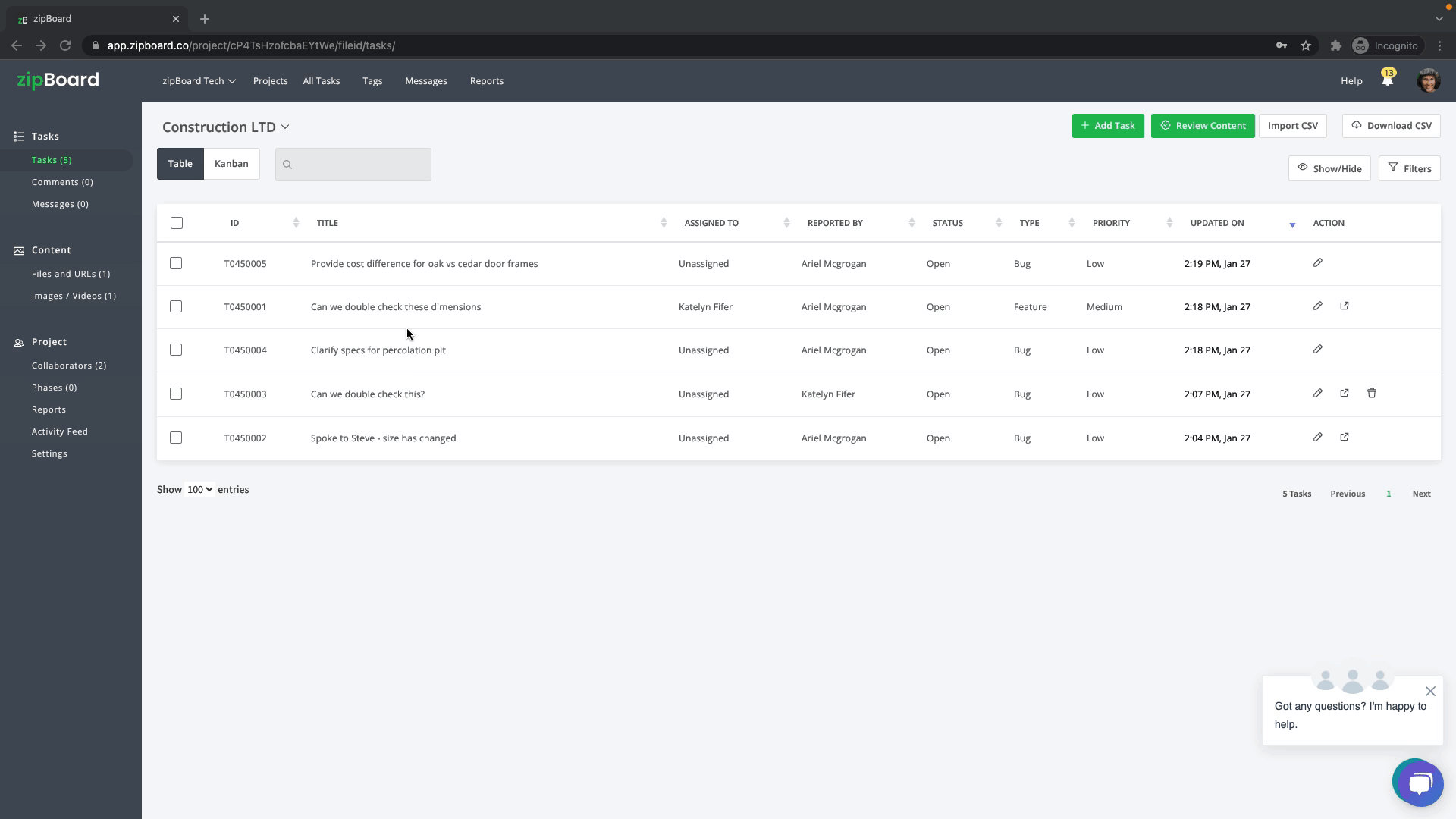
3. Provide Detail-Oriented Information
We have a saying about documentation: If it wasn’t documented, it didn’t happen. To put it another way, if you can’t prove that something happened on paper, then you cannot prove that it ever happened. No one wants to be faced with having to prove that a revision was made at the client’s request. So it’s important to understand the pros of documentation and why they’re so necessary.
Contextual feedback also allows for the contractors to easily understand the issue without having to hop onto a zoom call for every issue. This requires you to pinpoint the issue with precision.
4. Use Construction Specific Annotations
As mentioned earlier, annotation tools play a vital role in streamlining your review cycle. However, there are certain features that general annotation tools would not be able to accommodate.
Such as authenticating the document. Project managers often provide their stamp of approval on documents. For this, the tools would need to accommodate your stamps, signatures and timestamps at the very least. Like zipBoard doesn’t allow other users to move or delete these marks of authentication on a document. Ensuring the sanctity of the review.
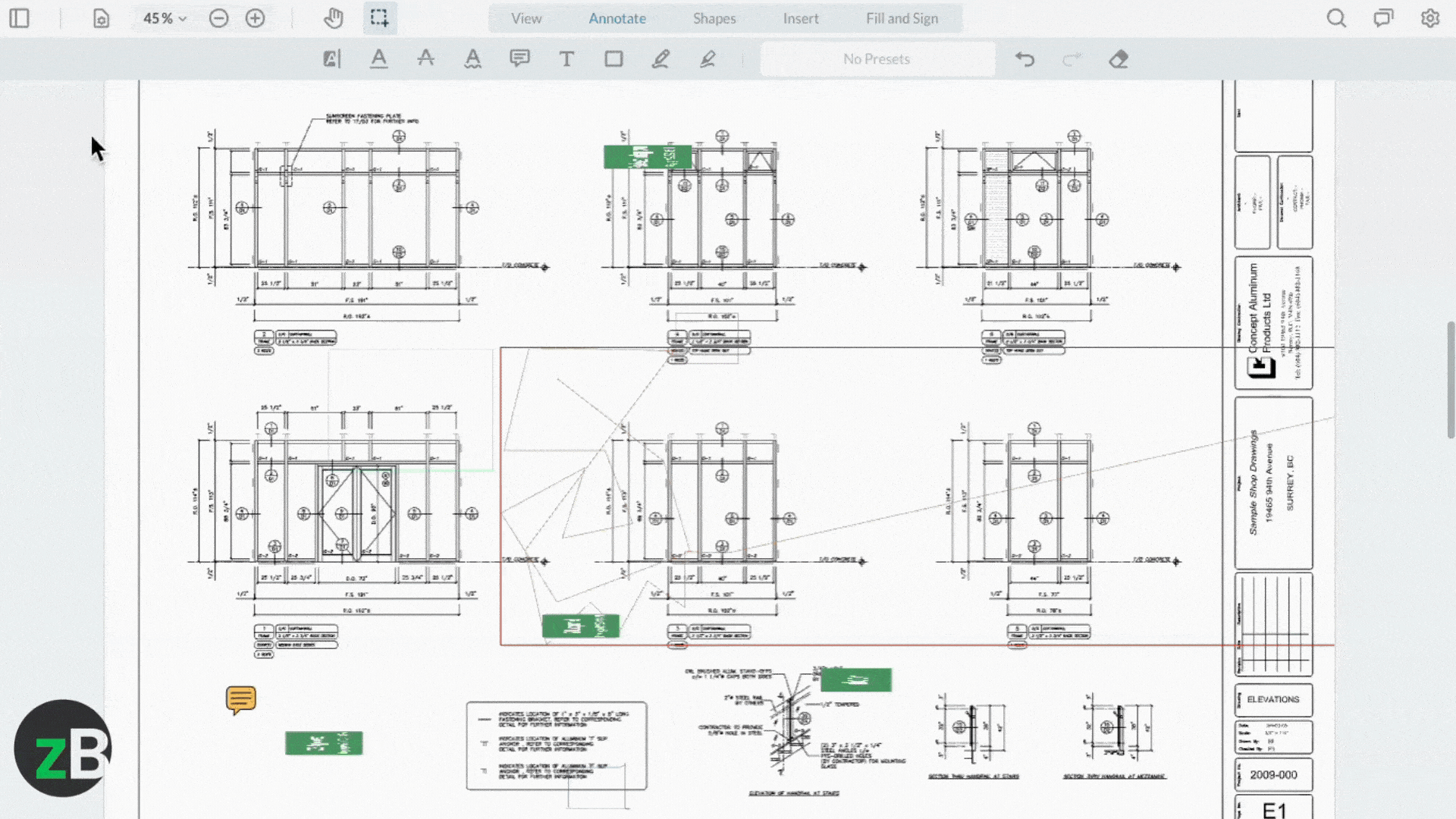
5. Understand the MasterFormat and UFGS
There are different formats when it comes to construction. And MasterFormat is the architecture, engineering, and construction (AEC) industry’s gold standard for organizing and communicating specifications and work results for construction projects.
The standard unifies your project. There are different subgroups in it, each having its standard specified. They’re especially important if you’re working in North America.
If you’re working in defense and aerospace construction, then UFGS is the standard for you. Unified Facilities Guide Specifications (UFGS) were mandated by the Department of Defense (USA) to integrate their specifications into one database. UFGS took effect in March 2001.
Knowing these formats will help you understand the various terms written in the construction submittal. At the same time, they’ll enable you to verify whether the right specifications have been met. Remember, having a good understanding of the standard is pivotal to speedy and error-free submittal reviews. So it’s a must to keep up with the specifications/standards of construction formats according to your geography.
6. Increase the Collaboration between GC and Subs
GCs as we know is the general contractors who are primarily tasked with taking up the construction and the submittals. Subs on the other hand are sub-contractors who take on parts of the overall job usually hired by the general contractors themselves.
Proper access and use of the submittal is a major pain point between the two. So, to increase collaboration and establish a unified approach to the project, a centralized database such as an SAP system goes a long way.
However, make sure that you provide them with just the right amount of access to it. Say, you have a bunch of reviews on a document, and you do not want them to mess with any of it. You need the ability to share the file as a view only. This means they can only view the file without the ability to edit or add any comments.
7. Integrate Operations and Maintenance (O&M) data
Operations and maintenance data/manual are conditions that may lead to operation and maintenance issues. It requires facility operations and maintenance personnel, monitoring and control requirements, communication requirements, and requirements for preparing the designers’ report.
This section covers the activities, processes, and workflows that you implement to ensure the smooth running of your operation, including:
- Structural maintenance of buildings.
- Control and maintenance of building systems like electrical, plumbing, HVAC, and security.
- Gardening, groundskeeping, and site improvements.
- Interior, furniture, and equipment maintenance.
For instance, if you’re working for the telecommunications industry, cabling can also come under the operations and maintenance teams.
Apart from preventing deterioration of your buildings and equipment, construction asset management software plays a critical role by helping track equipment lifecycles, schedule maintenance, and document inspections—ensuring no detail is overlooked throughout the O&M phase—while also improving workplace safety, lowering capital repair costs, increasing uptime, and reducing overall building ownership expenses.
Operationally, you want to run equipment at full capacity at all times to produce the maximum amount of goods. In maintenance, you recognize the importance of inspecting, maintaining, repairing, and replacing equipment to maintain its performance and useful life, even if this reduces production temporarily.
And this is where proper documentation and review comes in. Make sure that there’s proper review and approval of the same beforehand.
8. Organize a Pre-construction conference
Pre-construction conferences or “pre-job meetings” should be scheduled and conducted before beginning fieldwork on the project.
The following tasks will probably begin or be finished before the pre-construction conference: getting permissions, notifying utilities and/or railroads, or reviewing construction submittals.
However, it’s more probable than not that a few things from the submittal review process will need to be included here.
These consist of:
- The contractor’s schedule for advancement.
- A breakdown of any potential partial or recurring payments.
- A list of suppliers and/or subcontractors
- As well as shop drawings(see the types of construction submittals) of particular construction elements that belong to the contractor.
9. Clarify and correct issues in the shortest amount of time
None of us wants a spiraling review loop that requires a phone call or a video chat every time new feedback is added. The only way to avoid this is to make sure the feedback you provide is in context. Say, engineer A asks to decrease the cantilever size of the first floor, room B. The only way to avoid the extra step of making a call or messaging them is to pinpoint the issue in a construction submittal review tool. This way you’re not only saving time but also ensuring that the next revision arrives at the earliest.
Steps to provide contextual feedback in the construction submittal process:
- Clearly explain what is needed in each feedback.
- Make sure that you mention any dependencies in the feedback itself. Be it another document or a team member.
- Ensure that there is no contradictory feedback.
- Use a dedicated construction submittal review tool
Now that you’re aware of the 9 actionable strategies to improve your construction submittal process, it’s time to put them into use9/.
How can zipBoard Improve Your Construction Submittal Process?
When you have thousands of documents piling up on your system, and you’re pulling your hair over how to start reviewing, that’s where zipBoard comes in.
zipBoard is a submittal review tool that streamlines your construction submittal process with its multitude of annotation features.
There are five major reasons to use zipBoard for construction submittal process review:
- Mark-up tools to enable you keep each review in context.
- Integrates with your ERP/system seamlessly.
- Annotation tools to fit the construction world.
- Once you’re satisfied, sign off your submittals digitally and generate punch lists to take them to the field.
- Allows you to create custom features on-demand, as each agency’s need is different to the other.
- Collaborate with all stakeholders in one platform
- Keeps your documents secure in one place
- Helps you start construction 50% faster because you get to save time on reviews when you use zipBoard
There’s no rush though. Implement these actionable strategies today and if you require any help with your construction submittal process, zipBoard is always here for you.
Streamline Your Construction Submittal Process with zipBoard
Start your free trial or book a demo today so that we can create a tailored solution for you.
Book DemoStart Free TrialFAQs
The submittal process in construction involves submitting project documents, such as drawings, material specifications, and product data, from contractors to architects, engineers, or project managers for review and approval. This ensures that materials and designs meet project requirements before construction begins.
To process a submittal, contractors prepare the required documents, such as shop drawings, samples, or product data. They submit these documents to the project’s design team or approval authority. Reviewers check the submittal for compliance with project specifications and either approve, reject, or request revisions, ensuring project standards are met.
The three common types of submittals in construction are:
- Shop Drawings: Detailed drawings showing how specific project elements will be constructed.
- Product Data: Manufacturer’s specifications and information about materials, products, and systems.
- Samples: Physical examples of materials, finishes, or colors used for approval before installation.
The construction process typically involves these key steps:
- Pre-construction Planning: Establishing project goals, budgets, and timelines.
- Design and Documentation: Creating architectural and engineering designs, including submittals.
- Procurement: Sourcing materials, labor, and equipment.
- Construction: Executing the project according to the approved plans.
- Quality Control and Inspection: Ensuring the work meets specifications and standards.
- Project Handover and Closeout: Delivering the completed project to the client with necessary documentation and warranties.
Author’s bio:
Gaurav is a SaaS Marketer at zipBoard. While earning his degree in CSE at KIIT, Bhubaneswar, he rediscovered his inner love for creativity as he got into his first social internship. If he isn’t busy working, you can find him around his friends/family or enjoying a good football match or a passionate discussion over it, whichever works.
Last update: November 27, 2024.
Recent Posts
- Why Your Team Needs a Content Feedback System (Not Just Comments in Docs) May 28, 2025
- Content Approvals Are Slowing You Down — Here’s the Fix May 26, 2025
- How to Streamline Content Review and Approval — Best Practices, Tools & Automation May 12, 2025
- What Is Content Operations? And Why It Breaks Without a Feedback & Approval System May 3, 2025
- Why Designers Need a Website Visual Feedback Tool: Improve Design Reviews & Client Collaboration April 25, 2025
©️ Copyright 2023 zipBoard Tech. All rights reserved.

